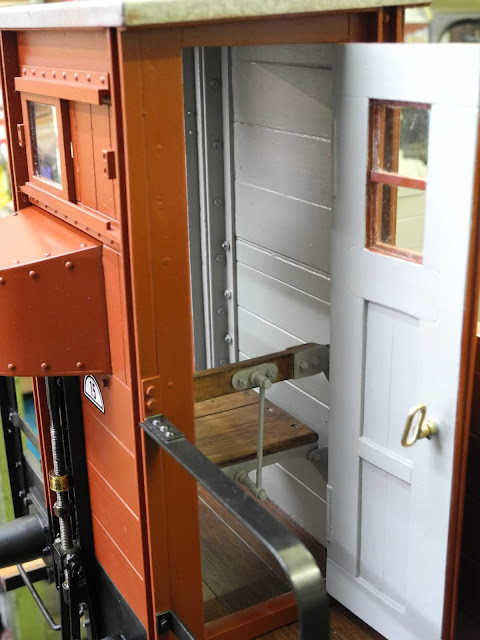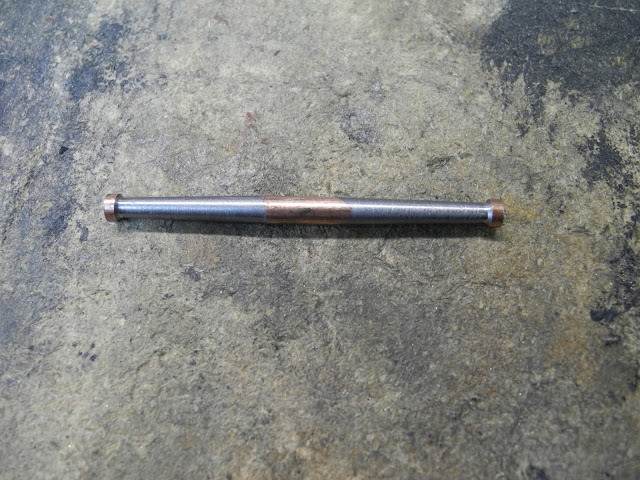This is the final part of this Omk wagon. After almost two years, the wagon/driving truck is now ready.
Omk is a telegraph code given to these wagons. Different to the British system of the Great Western Railway is that it is not just a name. The letters Omk show in detail what type of wagon it is.
O stands for: Offene Güterwagen mit 15 t Tragfäghigkeit (open wagon with a loading capacity of 15 metric tons).
m stands for: Mittelbord (middle size height of the side boards)
k stands for: Kopfwand drehbar zum abstürzen der Ladung (end of the wagon has an movable flap, so the wagon can be tipped over for unloading)
In the book of German railway wagons there is a lot of information about the colours; Anstrich und Bezeichnung von Güter- und Dienstwagen by Wolfgang Diener (Painting and lettering of wagons). There is also a photo that shows that the inside of the brakeman's cabin is grey. So this was done by using a brush.
The seat box is provided with rubber strips glued on the bottom. This makes sure that it will stay in place during the ride.
Lamp irons
The last thing to be made are the lamp irons and end signals. This German design consists of a conical square, in which an oil lamp or signal can be placed.
This conical square is formed with a homemade mandrel. Copper pipe is deductible enough to form
The mandrell (below in this picture) is milled to shape, with the aid of a dividing head in the milling machine. The copper pipe is 8 mm square (top) and about 9 mm high. The wall thickness is only 1 mm.
From 5 mm steel the post is turned...
... and bended about 95 degrees. With a file the end is shaped, so it will fit the copper square.
A simple, but effective set-up for silver soldering the post to the square. It's aligned on eye sight.
The two lamp irons were soldered as one piece, and cut in two afterwards. This way of doing it has the advantage that the part is of a reasonable length, so I can check the alignment easier.
On the other end a piece of strip is soldered on, again a larger strip helps to see if everything is aligned. Here the mandrel will help to adjust the alignment before soldering.
The very last bit of alignment (making sure it is vertical in both sides) can be done, once it is screwed to the wagon.
In the back, a full size end signal from the Deutsche Bundesbahn.
Painting the lamp iron with a small airbrush.
The signal plate is filed of 1,5 mm steel plate. A bit of garden wire is rolled to get it straight...
.. and bended into shape. This will be the handgrip.
On the real signal plate 'DB' is stamped, so I thought that a 'W ' (Württemberg) would be appropriate.
The vice of the milling machine is put to use as a press. This way all the W's look the same.
In Solidworks the drawing is now also completed.
This is necessary, so a DXF file can saved, to be used for the cutting plotter.
With a white background and red triangle it looks like the real thing.
There is a nice website about these end signals and lamps. (don't forget to scroll on that website down for the history and some beautiful pictures).
The signal plate in the lamp iron. Miniature oil lamps are also on the wish list to be made.
Still during the Corona lockdown: in the living room a first look at the wagon behind the loco.
So a test on the track is still something for the future.
Cleaning the wagon, after a few years of use. (16 Oktober 2023). It collected dirt like a real railway wagon.
Meanwhile the next project is already on the drawing board (or better put: on the computer in Solidworks). This will be the wagon for all the things needed on a day at the track.

















































































